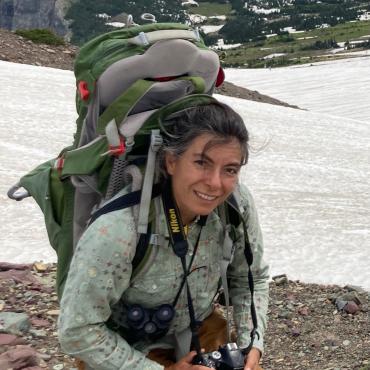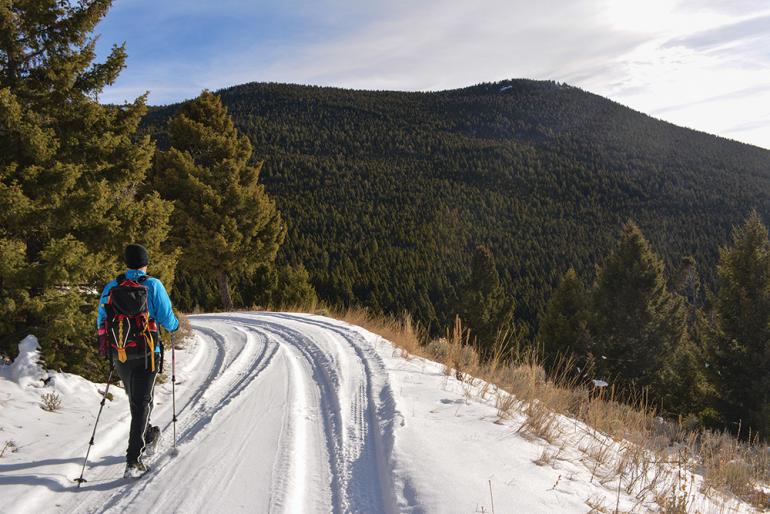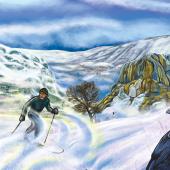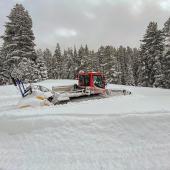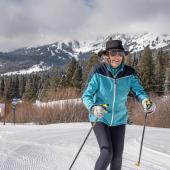Hidden Haunts
Exploring Elkhorn's winter trails.
Outside the old mining town of Elkhorn, winter lobs a sublime quirk, magical as rainbows after rain: following fresh snowfall, dreamy ski roads appear.
Phantom miners? Railroad barons seeking fortune? I’m all in for magic, but rainbows can be explained, and so can Elkhorn’s ski trails. In the ghost town still home to a handful of permanent residents, one generous local drags a bedspring by snowmobile to groom popular winter roads.
To explore Elkhorn in all its winter eccentricity, drive the back road toward Boulder. At the head of a narrow gorge draining the Elkhorn Mountains, the historic town settles into its mound of mines. The weathered camp shoulders tarnish, but winter roads trace haul grades that once shuttled loads of ore and salt, miners and woodcutters, by rail or wheel or beast, through the gulches and glades of the country’s once-most-productive silver-mining camp. A foray by ski or snowshoe reveals the anthill of the Elkhorn district overcome by forest, its chambers and transport tracks still traceable under snow.
As Elkhorn constitutes Montana’s smallest state park, Jefferson County maintains the road into town year-round, where frontier facades head up a private strip of historic structures.
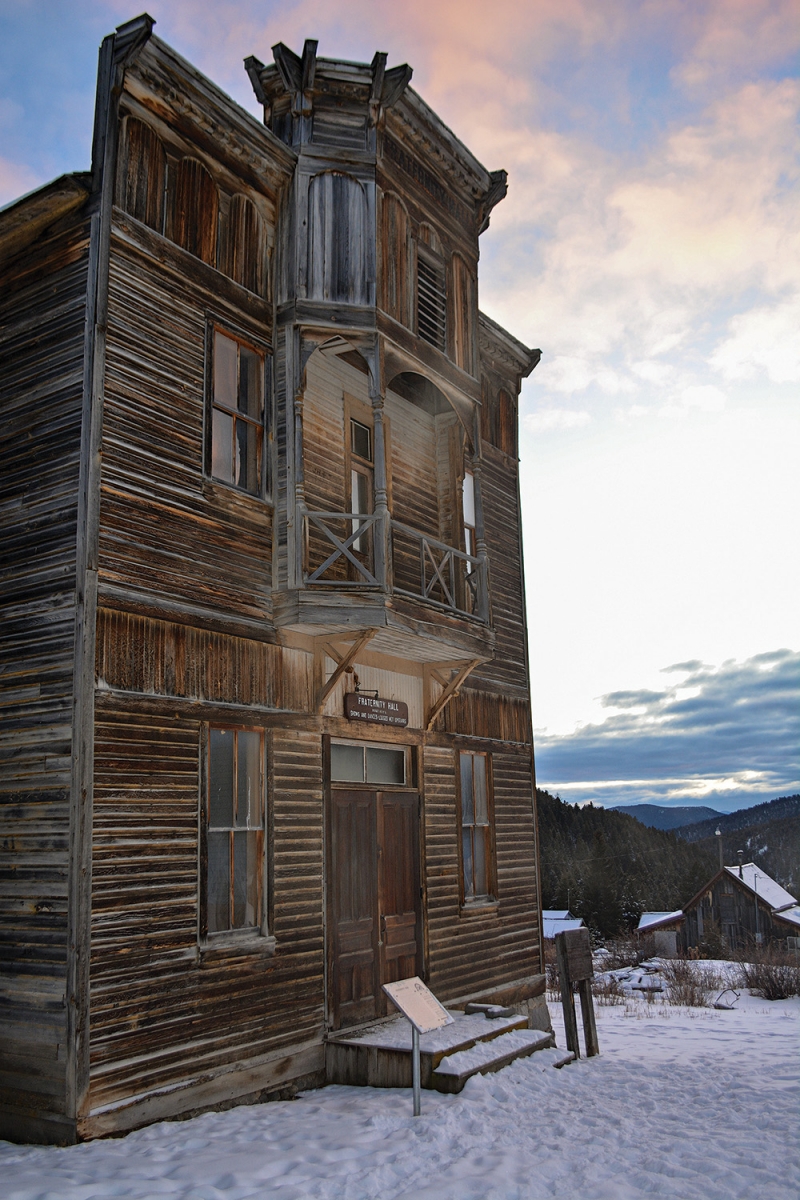
Winter foot travel crosses varied terrain. Pack some flexibility with a choice of gear, for in the spirit of frontier risk you may be testing your fortune: some lower sections can be icy, rocky, chomped by snowmobile, or all of the above, especially before the end of January. Fresh early snow load sweetens the deal, but expect optimal conditions later in the season. You may be laying trail, but if you time your trip to match snowfall you’ll land paydirt, the powder like heaven. And you just might catch the coat-tails of a magical bedspring grooming.
The hills are hatched with the boundaries of old mine sites: Keene, Dunstone, C & D, Louise, Golden Moss, Union, Elkhorn Queen. If exploring off-trail, pack your GPS and respect private holdings as you kick off into the solitude of a silver era gilded in snow.
Queen Gulch
A bitter railroad rivalry spurred heyday passage into Elkhorn. In 1887, the Northern Pacific and Montana Central railroads slapped close and spiteful tracks from Helena west through Boulder in their mad bid to tap Butte’s copper deposits. When Montana Central won the race, the NP abandoned its efforts and swiveled to broach the booming Elkhorn camp in need of reliable transportation. The first train from Boulder arrived in Elkhorn in 1890.
Guided by ghost rails, a gentle “groomed” creekside trek up Queen Gulch funnels between fir ridges with the potential for steeper exploit. About 1.5 miles before Elkhorn, park at the obvious gulch on your right, the old rail site of Queen Siding. Trains once swung through here to avoid the final, direct 1,000-foot gain to Elkhorn. In a route now obscured up the gulch’s north ridge, the steam locomotive hatched a four-mile approach instead up a 4% grade, hooking an impossible curve to bridge a side canyon across a 320-foot, four-tier wooden trestle and summit the Elkhorn depot, now gone, once the highest point on NP rails at about 6,400 feet.
A private cabin 2.5 miles up Queen Gulch marks an intersection and a moment of decision: retrace your tracks downhill to your vehicle, wind left up Tramway Road another two miles toward Elkhorn, or skin up and forge forward on the steep, untracked road toward Leslie Lake.
If the road climb fails to grip you, peer right through trees where the route opens briefly past Hobo Gulch. The Radersburg Pass Loop, obscure when snowbound, mounts a short climb in deep powder, hooks south through a ridgetop meadow, then drops past Deadman Spring to follow contour back to the cabin in Queen Gulch. Scout the route ahead of time or be confident in your navigational abilities. In the words of a 1978 description, “there are no steep hills or dangerous spots as long as you do not get lost.”
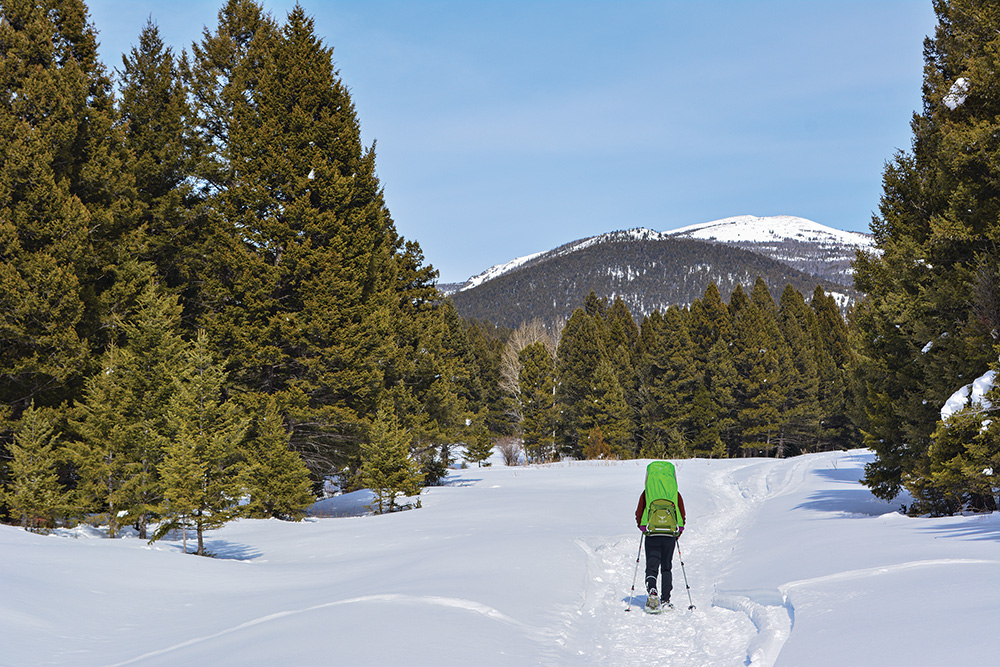
Queen Gulch: on her majesty's secret surface
Tramway Road
To fuel the flare of enterprise, woodcutter camps thrived along Elkhorn gulches. The small army denuded hillsides, roped cordwood stacks to their beasts of burden, and drove them up tram roads to fire voracious mill boilers.
Narrow rails along Tramway Road once accommodated mule-drawn carts. The road, minus the rails and tamped by bedspring, provides a gradual, picturesque, 4.25-mile descent from Elkhorn into Queen Gulch, requiring a shuttle.
Park one vehicle at Queen Gulch. Continue through Elkhorn to park in a small cleared corner, where the road hooks right above town. Beyond the cemetery, a winding descent brings you to the creek bottom and a forested cruise to your vehicle.
Diego Town Road
With access to Elkhorn and Crow, the range’s two loftiest peaks, the road north out of Elkhorn climbs gently, then gathers difficulty. In the 1930s, skiers kicked off from either summit before two rope tows led to the base of Elkhorn Peak for a lighted run 2,000 feet long, closed in 1941.
Park above town and follow signage toward the Iron Mine. Pass the NP water tank, the oldest in the region with a capacity of 48,000 gallons, built in 1890 and recently restored.
The increasing pitch of Diego Town Road skirts remnant structures, offers tangents into the woods, and may require skins on skis. For a coasting, untracked descent, skiable with free heels if that’s the gear you’ve got, bear left at a prominent Y junction to climb steep curves. Two miles up the road from Elkhorn, a narrow park unfurls down a west ridge with views into the Boulder Valley. Launch off toward the lower clearing and rejoin Diego Town Road for a curvy glide back to your vehicle.
Elkhorn Spirits
This ghost town’s most haunting absence is the death of its many saloons. Reanimate your bones in Boulder. The true-grit Windsor Bar throws down the thickest, meanest, saltiest slab of sirloin this side of boomtown, along with a cold one. Crave elk burger in the shadow of the Elkhorns? Burger options at the Mountain Good will crush the specter of ski fatigue. Vanquish your caffeine poltergeist at the Sweet Spot, where monster cinnamon rolls rival equally delectable pastry demons.
Reputed hauntings abound at Boulder Hot Springs, originally an 1863 saloon and bathhouse. Once a rail stop on NP’s Elkhorn line, the rustic inn and spa has been built up and refurbished many times over.
As for Elkhorn’s phantom miners and grooming apparitions, those are yours to discover.
Where is Elkhorn?
Take I-90 west to the Cardwell exit. Off the frontage road, follow Hwy. 69 north from Cardwell for 25 miles. Turn right at the Elkhorn sign, onto White Bridge Lane. Cross the Boulder River and continue right for three miles, keeping left onto Elkhorn Road, then left again eight miles more into Elkhorn. —Vaia Errett
Vaia Errett is one of seven volunteers serving on the Jefferson County Parks, Trails, and Recreation Commission. For trail descriptions and county geography, visit jeffersoncounty-mt.gov/trails.html.

